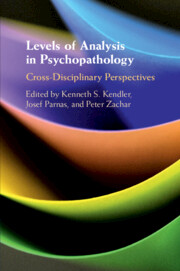Book contents
- Levels of Analysis in Psychopathology
- Advance Praise for Levels of Analysis in Psychopathology
- Levels of Analysis in Psychopathology
- Copyright page
- Contents
- Figures
- Tables
- Contributors
- Preface
- General Introduction
- Part I Neuroscience, Mechanisms, and RDoC
- Part II Phenomenology, Biological Psychology, and the Mind–Body Problem
- Part III Taxonomy, Integration, and Multiple Levels of Explanation
- Section 8
- 22 Introduction
- 23 Descriptive Psychopathology: A Manifest Level of Analysis, or Not?
- 24 Psychiatry without Description
- Section 9
- Section 10
- Section 11
- Section 12
- Section 13
- Section 14
- Section 15
- Index
- References
23 - Descriptive Psychopathology: A Manifest Level of Analysis, or Not?
from Section 8
Published online by Cambridge University Press: 02 April 2020
- Levels of Analysis in Psychopathology
- Advance Praise for Levels of Analysis in Psychopathology
- Levels of Analysis in Psychopathology
- Copyright page
- Contents
- Figures
- Tables
- Contributors
- Preface
- General Introduction
- Part I Neuroscience, Mechanisms, and RDoC
- Part II Phenomenology, Biological Psychology, and the Mind–Body Problem
- Part III Taxonomy, Integration, and Multiple Levels of Explanation
- Section 8
- 22 Introduction
- 23 Descriptive Psychopathology: A Manifest Level of Analysis, or Not?
- 24 Psychiatry without Description
- Section 9
- Section 10
- Section 11
- Section 12
- Section 13
- Section 14
- Section 15
- Index
- References
Summary
To define descriptive psychopathology as classification of disorders with respect to manifest signs and symptoms as opposed to deeper causes is a somewhat superficial construal that does not take into account the various ways that something can be brought under a description.The philosopher’s notion of bringing something under a description can be illustrated by a non-behaviorist reading of Gilbert Ryle’s book The Concept of Mind. That things can be brought under more than one description highlights the importance of re-describing. An important example of re-describing psychopathology is the discovery of panic disorder from which five desiderata for useful descriptions and re-descriptions can be derived. With respect to causes, the elucidation of a causal model for a phenotype can often lead us to notice something descriptively that we had not noticed before, in which case the causal model becomes part of a thicker description of the phenotype.
- Type
- Chapter
- Information
- Levels of Analysis in PsychopathologyCross-Disciplinary Perspectives, pp. 280 - 296Publisher: Cambridge University PressPrint publication year: 2020

